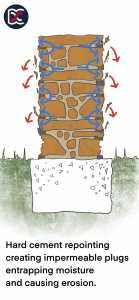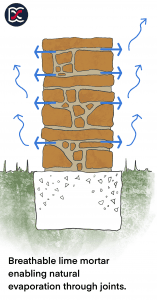Northamptonshire Sandstone
The richly coloured sandstones of Northamptonshire are formed from compressed marine sediments that date to the Jurassic Age. They have been used as local building materials since Saxon times and include notable ecclesiastical buildings such as Brixworth Church – the largest Saxon Church in England. Northamptonshire sandstone can, however, be relatively soft and is susceptible to erosion, particularly in exposed locations.
The Correct Type of Mortar
The type of mortar that is used to bond the stones together can play an important part in ensuring this erosion is kept to a minimum.
The traditional material for mortar joints is lime. Lime acts in a sacrificial capacity to the stone. It is, in effect, a ‘wick’ and helps to pull moisture away from the wall. This protects the stone from saturation and potential frost damage during the winter months. Lime mortar is also flexible and is able to accommodate the seasonal movements that occur in buildings without suffering from cracks.
Hard Cement Mortars
Unfortunately, for the last 70 years or so, cement has become the first choice as a mortar for most building companies. Cement is easier mix in large batches and cures (or sets) much more rapidly than lime enabling faster build times and, of course, larger profits. These benefits do come at a price though. The intrinsic ability to cure quickly results in a hard and inflexible mortar joint that is susceptible to cracking. The hard cement mortar is also impermeable which means that water remains trapped within surrounding stone.
Sacrificial Lime Mortars
Lime, whilst supposedly being more difficult to use, does not suffer from these problems owing to two distinctive properties:
1) Plasticity:
Many period properties that are built using lime mortar have characteristic leans and bulges to the external wall surfaces, but mostly without any noticeable cracks. This is due to the ability of lime to ‘self-heal’. When it becomes wet, any cracks dissolve and the lime then resets itself in a new position.
2) Breathability:
Lime mortars are vapour permeable and generally softer than the surround masonry wall. Any rain water that soaks into a wall is naturally evaporated away through the lime mortar joints. Many surveyors refer to this inherent ability of lime as being the ‘lungs’ of the house enabling it to ‘breath’.
Future Repairs
Lime mortar is ultimately a sacrificial material and it will eventually deteriorate. At this point repointing becomes necessary. It is essential that the replacement mortar for the repointing be of a suitable lime mix with little or no cement content. Very often we see hard grey cement repointing works to Northamptonshire sandstone that, over the course of just a few years, causes irreparable damage to the surface of the stone. The services of an experienced contractor with knowledge of lime mortars will pay dividends when it comes to repointing stone walls and will help avoid future damage to the stone and expensive repair bills.
We hope you have found our article interesting. Our sales and lettings team here at David Cosby has legal and surveying expertise to ensure you receive the highest standard of service and the best professional advice on all your property-related matters. Whether you are renting, letting, buying, selling a property, or simply have a property-related question, please contact us by clicking the link below, or call us on 01604 979628.




